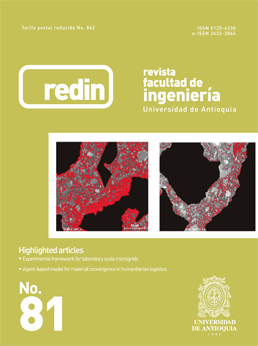Evaluación del impacto ambiental de tres tipos de fertilizantes en el cultivo de café del resguardo indígena Las Delicias (Cauca) a partir del análisis de ciclo de vida
DOI:
https://doi.org/10.17533/udea.redin.n81a09Palabras clave:
Análisis de ciclo de vida (ACV), café orgánico, comunidad indígenaResumen
Este trabajo busca evaluar y comparar el desempeño ambiental de tres tipos de fertilizantes en la producción de café a partir de la aplicación de la metodología de análisis de ciclo de vida en el resguardo indígena Las Delicias (ubicado en el Norte del Departamento del Cauca) a fin de estandarizar los procesos. En este sentido algunos caficultores emplean fertilizantes químicos, otros usan gallinaza y la mayoría emplea compost, trabajan con técnicas artesanales, y conservan sus tradiciones ancestrales y culturales en los procesos productivos. Del ACV se encontró que de los tres tipos de fertilizantes (fertilizantes químicos, gallinaza, y compost), el uso del compost presenta menores impactos en la categoría de cambio climático y la acidificación, mientras que el uso de fertilizante químico es mejor en la categoría de toxicidad terrestre y el uso de la tierra. Finalmente el uso de gallinaza obtuvo mejores desempeños en la categoría de toxicidad humana y eutrofización, por tal motivo la decisión que mejor se ajustaría de acuerdo a los resultados es la de fertilizar con compost ya que presenta menores impactos en acidificación del suelo.
Descargas
Citas
J. R. Chacón, “Historia ampliada y comentada del análisis de ciclo de vida (ACV): con una bibliografía selecta,” Rev. Esc. Colomb. Ing., vol. 18, no. 72, pp. 37-70, 2008.
International Organization for Standardization (ISO), ISO 14040:2006 Environmental management -- Life cycle assessment -- Principles and framework, 2006.[Online]. Available: http://www.iso.org/iso/catalogue_detail?csnumber=37456. Accessed on: Mar. 04, 2016.
Instituto Colombiano de Normas Técnicas y Certificación (ICONTEC), Análisis De Ciclo De Vida. Vocabulario, NTC 5459, 2007.
J. Kovanda, J. Weinzettel, and T. Hak, “Analysis of regional material flows: The case of the Czech Republic,” Resour. Conserv. Recycl., vol. 53, no. 5, pp. 243- 254, 2009.
H. Udo de Haes, “Industrial ecology and life cycle assessment,” in Handbook of Industrial Ecology, R. U. Ayres and L. W. Ayres (eds). Cheltenham, UK: Edward Elgar, 2002, 138−148.
Product Carbon Footprint (PCF) Project, Case study tchibo privat kaffee rarity machare by tchibo GmbH,2008. [Online]. Available: http://www.pcf-projekt.de/files/1232962944/pcf_tchibo_coffee.pdf. Accessed on: Mar. 04, 2016.
M. Segura and H. Andrade, “Huella de carbono en cadenas productivas de café (Coffea arabica L.) con diferentes estándares de certificación en Costa Rica,” Luna Azul, vol. 1, no. 35, pp. 60-77, 2012.
M. Noponen et al., “Greenhouse gas emissions in coffee grown with differing input levels under conventional and organic management,” Agric. Ecosyst. Environ., vol. 151, pp. 6-15, 2012.
Federación Nacional de Cafeteros de Colombia (FNC) and Centro Nacional de Investigaciones de Café (Cenicafé), Manual del cafetero colombiano. Investigación y tecnología para la sostenibilidad de la caficultura. Bogotá, Colombia: FNC / Cenicafé, 2013.
A. L. Mourad, L. Coltro, P. Oliveira, R. M. Kletecke, and J. P. Baddini, “A simple methodology for elaborating the life cycle inventory of agricultural products,” Int. J. Life Cycle Assess., vol. 12, no. 6, pp. 408-413, 2007.
Instituto de Hidrología, Meteorología y Estudios Ambientales de Colombia (IDEAM), Región andina precipitación, 2015. [Online]. Available: http://www.ideam.gov.co/web/tiempo-y-clima/region-andina-precipitacion. Accessed on: Jun. 28, 2016.
Descargas
Publicado
Cómo citar
Número
Sección
Licencia
Derechos de autor 2018 Revista Facultad de Ingeniería

Esta obra está bajo una licencia internacional Creative Commons Atribución-NoComercial-CompartirIgual 4.0.
Los artículos disponibles en la Revista Facultad de Ingeniería, Universidad de Antioquia están bajo la licencia Creative Commons Attribution BY-NC-SA 4.0.
Eres libre de:
Compartir — copiar y redistribuir el material en cualquier medio o formato
Adaptar : remezclar, transformar y construir sobre el material.
Bajo los siguientes términos:
Reconocimiento : debe otorgar el crédito correspondiente , proporcionar un enlace a la licencia e indicar si se realizaron cambios . Puede hacerlo de cualquier manera razonable, pero no de ninguna manera que sugiera que el licenciante lo respalda a usted o su uso.
No comercial : no puede utilizar el material con fines comerciales .
Compartir igual : si remezcla, transforma o construye a partir del material, debe distribuir sus contribuciones bajo la misma licencia que el original.
El material publicado por la revista puede ser distribuido, copiado y exhibido por terceros si se dan los respectivos créditos a la revista, sin ningún costo. No se puede obtener ningún beneficio comercial y las obras derivadas tienen que estar bajo los mismos términos de licencia que el trabajo original.










 Twitter
Twitter